|
SNAP Library 2.2, Developer Reference
2014-03-11 19:15:55
SNAP, a general purpose, high performance system for analysis and manipulation of large networks
|
|
SNAP Library 2.2, Developer Reference
2014-03-11 19:15:55
SNAP, a general purpose, high performance system for analysis and manipulation of large networks
|
#include <linalg.h>
Public Types | |
| enum | TLinAlgGemmTranspose { GEMM_NO_T = 0, GEMM_A_T = 1, GEMM_B_T = 2, GEMM_C_T = 4 } |
| enum | TLinAlgInverseType { DECOMP_SVD } |
Static Public Member Functions | |
| static double | DotProduct (const TFltV &x, const TFltV &y) |
| static double | DotProduct (const TFltVV &X, int ColIdX, const TFltVV &Y, int ColIdY) |
| static double | DotProduct (const TFltVV &X, int ColId, const TFltV &Vec) |
| static double | DotProduct (const TIntFltKdV &x, const TIntFltKdV &y) |
| static double | DotProduct (const TFltV &x, const TIntFltKdV &y) |
| static double | DotProduct (const TFltVV &X, int ColId, const TIntFltKdV &y) |
| static void | LinComb (const double &p, const TFltV &x, const double &q, const TFltV &y, TFltV &z) |
| static void | ConvexComb (const double &p, const TFltV &x, const TFltV &y, TFltV &z) |
| static void | AddVec (const double &k, const TFltV &x, const TFltV &y, TFltV &z) |
| static void | AddVec (const double &k, const TIntFltKdV &x, const TFltV &y, TFltV &z) |
| static void | AddVec (const double &k, const TIntFltKdV &x, TFltV &y) |
| static void | AddVec (double k, const TFltVV &X, int ColIdX, TFltVV &Y, int ColIdY) |
| static void | AddVec (double k, const TFltVV &X, int ColId, TFltV &Result) |
| static void | AddVec (const TIntFltKdV &x, const TIntFltKdV &y, TIntFltKdV &z) |
| static double | SumVec (const TFltV &x) |
| static double | SumVec (double k, const TFltV &x, const TFltV &y) |
| static double | EuclDist2 (const TFltV &x, const TFltV &y) |
| static double | EuclDist2 (const TFltPr &x, const TFltPr &y) |
| static double | EuclDist (const TFltV &x, const TFltV &y) |
| static double | EuclDist (const TFltPr &x, const TFltPr &y) |
| static double | Norm2 (const TFltV &x) |
| static double | Norm (const TFltV &x) |
| static void | Normalize (TFltV &x) |
| static double | Norm2 (const TIntFltKdV &x) |
| static double | Norm (const TIntFltKdV &x) |
| static void | Normalize (TIntFltKdV &x) |
| static double | Norm2 (const TFltVV &X, int ColId) |
| static double | Norm (const TFltVV &X, int ColId) |
| static double | NormL1 (const TFltV &x) |
| static double | NormL1 (double k, const TFltV &x, const TFltV &y) |
| static double | NormL1 (const TIntFltKdV &x) |
| static void | NormalizeL1 (TFltV &x) |
| static void | NormalizeL1 (TIntFltKdV &x) |
| static double | NormLinf (const TFltV &x) |
| static double | NormLinf (const TIntFltKdV &x) |
| static void | NormalizeLinf (TFltV &x) |
| static void | NormalizeLinf (TIntFltKdV &x) |
| static void | MultiplyScalar (const double &k, const TFltV &x, TFltV &y) |
| static void | MultiplyScalar (const double &k, const TIntFltKdV &x, TIntFltKdV &y) |
| static void | Multiply (const TFltVV &A, const TFltV &x, TFltV &y) |
| static void | Multiply (const TFltVV &A, const TFltV &x, TFltVV &C, int ColId) |
| static void | Multiply (const TFltVV &A, const TFltVV &B, int ColId, TFltV &y) |
| static void | Multiply (const TFltVV &A, const TFltVV &B, int ColIdB, TFltVV &C, int ColIdC) |
| static void | MultiplyT (const TFltVV &A, const TFltV &x, TFltV &y) |
| static void | Multiply (const TFltVV &A, const TFltVV &B, TFltVV &C) |
| static void | Gemm (const double &Alpha, const TFltVV &A, const TFltVV &B, const double &Beta, const TFltVV &C, TFltVV &D, const int &TransposeFlags) |
| static void | Inverse (const TFltVV &A, TFltVV &B, const TLinAlgInverseType &DecompType) |
| static void | InverseSVD (const TFltVV &A, TFltVV &B) |
| static void | Transpose (const TFltVV &A, TFltVV &B) |
| static void | GS (TVec< TFltV > &Q) |
| static void | GS (TFltVV &Q) |
| static void | Rotate (const double &OldX, const double &OldY, const double &Angle, double &NewX, double &NewY) |
| static void | AssertOrtogonality (const TVec< TFltV > &Vecs, const double &Threshold) |
| static void | AssertOrtogonality (const TFltVV &Vecs, const double &Threshold) |
| void TLinAlg::AddVec | ( | const double & | k, |
| const TFltV & | x, | ||
| const TFltV & | y, | ||
| TFltV & | z | ||
| ) | [static] |
Definition at line 232 of file linalg.cpp.
References LinComb().
Referenced by GS(), TSparseSVD::Lanczos(), TSparseSVD::Lanczos2(), TFullColMatrix::PMultiply(), and TSparseSVD::SimpleLanczos().
{
LinComb(k, x, 1.0, y, z);
}


| void TLinAlg::AddVec | ( | const double & | k, |
| const TIntFltKdV & | x, | ||
| const TFltV & | y, | ||
| TFltV & | z | ||
| ) | [static] |
Definition at line 236 of file linalg.cpp.
References Assert, and TVec< TVal, TSizeTy >::Len().
{
Assert(y.Len() == z.Len());
z = y; // first we set z to be y
// and than we add x to z (==y)
const int xLen = x.Len(), yLen = y.Len();
for (int i = 0; i < xLen; i++) {
const int ii = x[i].Key;
if (ii < yLen) {
z[ii] = k * x[i].Dat + y[ii];
}
}
}

| void TLinAlg::AddVec | ( | const double & | k, |
| const TIntFltKdV & | x, | ||
| TFltV & | y | ||
| ) | [static] |
Definition at line 249 of file linalg.cpp.
References TVec< TVal, TSizeTy >::Len().
{
const int xLen = x.Len(), yLen = y.Len();
for (int i = 0; i < xLen; i++) {
const int ii = x[i].Key;
if (ii < yLen) {
y[ii] += k * x[i].Dat;
}
}
}

| void TLinAlg::AddVec | ( | double | k, |
| const TFltVV & | X, | ||
| int | ColIdX, | ||
| TFltVV & | Y, | ||
| int | ColIdY | ||
| ) | [static] |
Definition at line 259 of file linalg.cpp.
References Assert, and TVVec< TVal >::GetRows().
{
Assert(X.GetRows() == Y.GetRows());
const int len = Y.GetRows();
for (int i = 0; i < len; i++) {
Y(i,ColIdY) = Y(i,ColIdY) + k * X(i, ColIdX);
}
}

| void TLinAlg::AddVec | ( | double | k, |
| const TFltVV & | X, | ||
| int | ColId, | ||
| TFltV & | Result | ||
| ) | [static] |
Definition at line 267 of file linalg.cpp.
References Assert, TVVec< TVal >::GetRows(), and TVec< TVal, TSizeTy >::Len().
{
Assert(X.GetRows() == Result.Len());
const int len = Result.Len();
for (int i = 0; i < len; i++) {
Result[i] = Result[i] + k * X(i, ColId);
}
}

| void TLinAlg::AddVec | ( | const TIntFltKdV & | x, |
| const TIntFltKdV & | y, | ||
| TIntFltKdV & | z | ||
| ) | [static] |
Definition at line 275 of file linalg.cpp.
References TSparseOps< TKey, TDat >::SparseMerge().
{
TSparseOpsIntFlt::SparseMerge(x, y, z);
}

| void TLinAlg::AssertOrtogonality | ( | const TVec< TFltV > & | Vecs, |
| const double & | Threshold | ||
| ) | [static] |
Definition at line 616 of file linalg.cpp.
References TFlt::Abs(), DotProduct(), TVec< TVal, TSizeTy >::Len(), and Norm2().
{
int m = Vecs.Len();
for (int i = 0; i < m; i++) {
for (int j = 0; j < i; j++) {
double res = DotProduct(Vecs[i], Vecs[j]);
if (TFlt::Abs(res) > Threshold)
printf("<%d,%d> = %.5f", i,j,res);
}
double norm = Norm2(Vecs[i]);
if (TFlt::Abs(norm-1) > Threshold)
printf("||%d|| = %.5f", i, norm);
}
}

| void TLinAlg::AssertOrtogonality | ( | const TFltVV & | Vecs, |
| const double & | Threshold | ||
| ) | [static] |
Definition at line 630 of file linalg.cpp.
References TFlt::Abs(), DotProduct(), TVVec< TVal >::GetCols(), and Norm2().
{
int m = Vecs.GetCols();
for (int i = 0; i < m; i++) {
for (int j = 0; j < i; j++) {
double res = DotProduct(Vecs, i, Vecs, j);
if (TFlt::Abs(res) > Threshold)
printf("<%d,%d> = %.5f", i, j, res);
}
double norm = Norm2(Vecs, i);
if (TFlt::Abs(norm-1) > Threshold)
printf("||%d|| = %.5f", i, norm);
}
printf("\n");
}

| void TLinAlg::ConvexComb | ( | const double & | p, |
| const TFltV & | x, | ||
| const TFltV & | y, | ||
| TFltV & | z | ||
| ) | [static] |
Definition at line 227 of file linalg.cpp.
References AssertR, TFlt::GetStr(), and LinComb().
{
AssertR(0.0 <= p && p <= 1.0, TFlt::GetStr(p));
LinComb(p, x, 1.0 - p, y, z);
}

| double TLinAlg::DotProduct | ( | const TFltV & | x, |
| const TFltV & | y | ||
| ) | [static] |
Definition at line 165 of file linalg.cpp.
References TStr::Fmt(), IAssertR, and TVec< TVal, TSizeTy >::Len().
Referenced by AssertOrtogonality(), TLogRegFit::GetStepSizeByLineSearch(), TAGMFit::GetStepSizeByLineSearchForLambda(), GS(), TSparseSVD::Lanczos(), TSparseSVD::Lanczos2(), TLogRegFit::MLENewton(), Norm2(), TFullColMatrix::PMultiplyT(), and TSparseSVD::SimpleLanczos().
{
IAssertR(x.Len() == y.Len(), TStr::Fmt("%d != %d", x.Len(), y.Len()));
double result = 0.0; int Len = x.Len();
for (int i = 0; i < Len; i++)
result += x[i] * y[i];
return result;
}

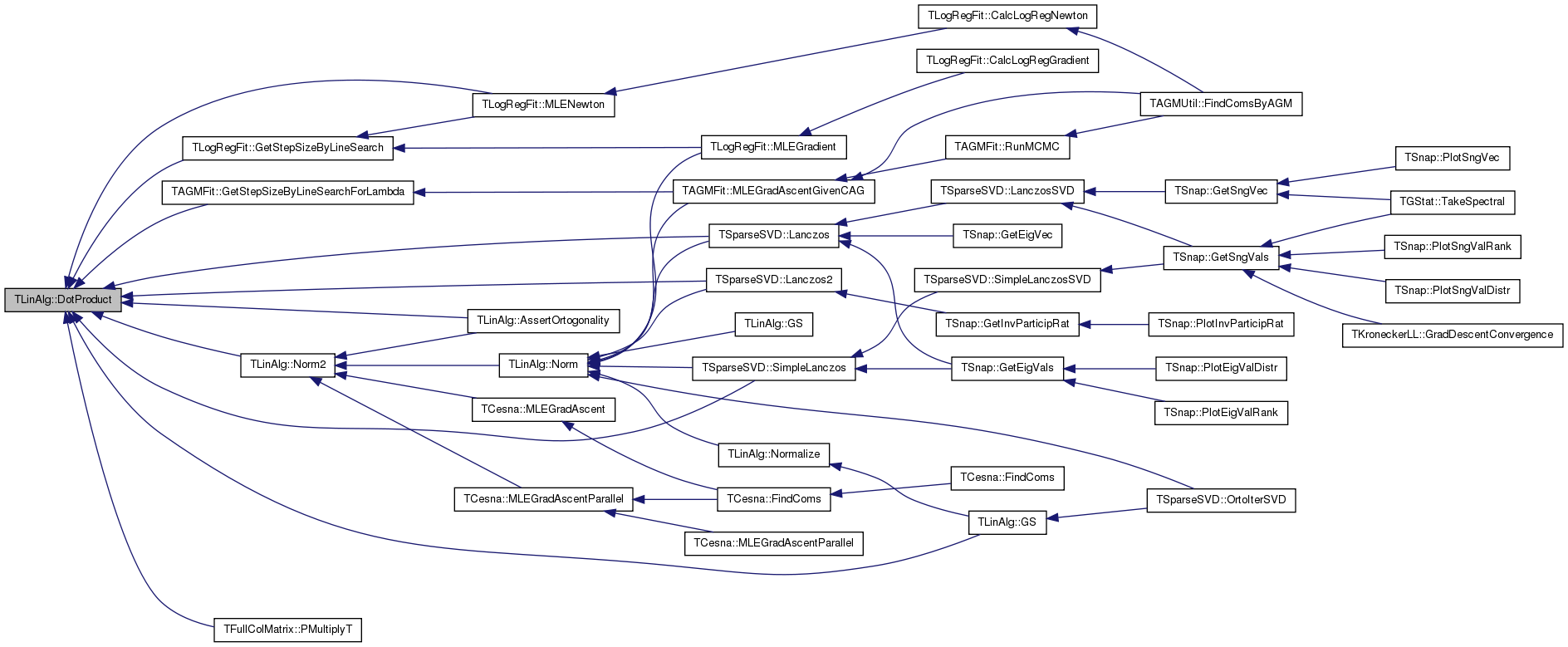
| double TLinAlg::DotProduct | ( | const TFltVV & | X, |
| int | ColIdX, | ||
| const TFltVV & | Y, | ||
| int | ColIdY | ||
| ) | [static] |
Definition at line 173 of file linalg.cpp.
References Assert, and TVVec< TVal >::GetRows().
{
Assert(X.GetRows() == Y.GetRows());
double result = 0.0, len = X.GetRows();
for (int i = 0; i < len; i++)
result = result + X(i,ColIdX) * Y(i,ColIdY);
return result;
}

| double TLinAlg::DotProduct | ( | const TFltVV & | X, |
| int | ColId, | ||
| const TFltV & | Vec | ||
| ) | [static] |
Definition at line 181 of file linalg.cpp.
References Assert, TVVec< TVal >::GetRows(), and TVec< TVal, TSizeTy >::Len().
{
Assert(X.GetRows() == Vec.Len());
double result = 0.0; int Len = X.GetRows();
for (int i = 0; i < Len; i++)
result += X(i,ColId) * Vec[i];
return result;
}

| double TLinAlg::DotProduct | ( | const TIntFltKdV & | x, |
| const TIntFltKdV & | y | ||
| ) | [static] |
Definition at line 189 of file linalg.cpp.
References TVec< TVal, TSizeTy >::Len().
{
const int xLen = x.Len(), yLen = y.Len();
double Res = 0.0; int i1 = 0, i2 = 0;
while (i1 < xLen && i2 < yLen) {
if (x[i1].Key < y[i2].Key) i1++;
else if (x[i1].Key > y[i2].Key) i2++;
else { Res += x[i1].Dat * y[i2].Dat; i1++; i2++; }
}
return Res;
}

| double TLinAlg::DotProduct | ( | const TFltV & | x, |
| const TIntFltKdV & | y | ||
| ) | [static] |
Definition at line 200 of file linalg.cpp.
References TVec< TVal, TSizeTy >::Len().
{
double Res = 0.0; const int xLen = x.Len(), yLen = y.Len();
for (int i = 0; i < yLen; i++) {
const int key = y[i].Key;
if (key < xLen) Res += y[i].Dat * x[key];
}
return Res;
}

| double TLinAlg::DotProduct | ( | const TFltVV & | X, |
| int | ColId, | ||
| const TIntFltKdV & | y | ||
| ) | [static] |
Definition at line 209 of file linalg.cpp.
References TVVec< TVal >::GetRows(), and TVec< TVal, TSizeTy >::Len().
{
double Res = 0.0; const int n = X.GetRows(), yLen = y.Len();
for (int i = 0; i < yLen; i++) {
const int key = y[i].Key;
if (key < n) Res += y[i].Dat * X(key,ColId);
}
return Res;
}

| double TLinAlg::EuclDist | ( | const TFltV & | x, |
| const TFltV & | y | ||
| ) | [static] |
Definition at line 312 of file linalg.cpp.
References EuclDist2().
{
return sqrt(EuclDist2(x, y));
}

| double TLinAlg::EuclDist | ( | const TFltPr & | x, |
| const TFltPr & | y | ||
| ) | [static] |
Definition at line 316 of file linalg.cpp.
References EuclDist2().
{
return sqrt(EuclDist2(x, y));
}

| double TLinAlg::EuclDist2 | ( | const TFltV & | x, |
| const TFltV & | y | ||
| ) | [static] |
Definition at line 298 of file linalg.cpp.
References Assert, TVec< TVal, TSizeTy >::Len(), and TMath::Sqr().
Referenced by EuclDist().
{
Assert(x.Len() == y.Len());
const int len = x.Len();
double Res = 0.0;
for (int i = 0; i < len; i++) {
Res += TMath::Sqr(x[i] - y[i]);
}
return Res;
}


| double TLinAlg::EuclDist2 | ( | const TFltPr & | x, |
| const TFltPr & | y | ||
| ) | [static] |
Definition at line 308 of file linalg.cpp.
References TMath::Sqr(), TPair< TVal1, TVal2 >::Val1, and TPair< TVal1, TVal2 >::Val2.
{
return TMath::Sqr(x.Val1 - y.Val1) + TMath::Sqr(x.Val2 - y.Val2);
}

| void TLinAlg::Gemm | ( | const double & | Alpha, |
| const TFltVV & | A, | ||
| const TFltVV & | B, | ||
| const double & | Beta, | ||
| const TFltVV & | C, | ||
| TFltVV & | D, | ||
| const int & | TransposeFlags | ||
| ) | [static] |
Definition at line 493 of file linalg.cpp.
References Assert, TVVec< TVal >::At(), GEMM_A_T, GEMM_B_T, GEMM_C_T, TVVec< TVal >::GetCols(), and TVVec< TVal >::GetRows().
{
bool tA = (TransposeFlags & GEMM_A_T) == GEMM_A_T;
bool tB = (TransposeFlags & GEMM_B_T) == GEMM_B_T;
bool tC = (TransposeFlags & GEMM_C_T) == GEMM_C_T;
// setting dimensions
int a_i = tA ? A.GetRows() : A.GetCols();
int a_j = tA ? A.GetCols() : A.GetRows();
int b_i = tB ? A.GetRows() : A.GetCols();
int b_j = tB ? A.GetCols() : A.GetRows();
int c_i = tC ? A.GetRows() : A.GetCols();
int c_j = tC ? A.GetCols() : A.GetRows();
int d_i = D.GetCols();
int d_j = D.GetRows();
// assertions for dimensions
bool Cnd = a_i == c_j && b_i == c_i && a_i == b_j && c_i == d_i && c_j == d_j;
if (Cnd) {
Assert(Cnd);
}
double Aij, Bij, Cij;
// rows
for (int j = 0; j < a_j; j++) {
// cols
for (int i = 0; i < a_i; i++) {
// not optimized for speed (!)
double sum = 0;
for (int k = 0; k < a_i; k++) {
Aij = tA ? A.At(j, k) : A.At(k, j);
Bij = tB ? B.At(k, i) : B.At(i, k);
sum += Alpha * Aij * Bij;
}
Cij = tC ? C.At(i, j) : C.At(j, i);
sum += Beta * Cij;
D.At(i, j) = sum;
}
}
}
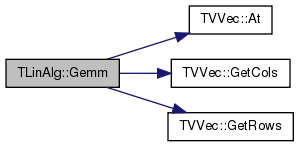
| void TLinAlg::GS | ( | TVec< TFltV > & | Q | ) | [static] |
Definition at line 584 of file linalg.cpp.
References AddVec(), DotProduct(), IAssert, TVec< TVal, TSizeTy >::Len(), and Normalize().
Referenced by TSparseSVD::OrtoIterSVD().
{
IAssert(Q.Len() > 0);
int m = Q.Len(); // int n = Q[0].Len();
for (int i = 0; i < m; i++) {
printf("%d\r",i);
for (int j = 0; j < i; j++) {
double r = TLinAlg::DotProduct(Q[i], Q[j]);
TLinAlg::AddVec(-r,Q[j],Q[i],Q[i]);
}
TLinAlg::Normalize(Q[i]);
}
printf("\n");
}


| void TLinAlg::GS | ( | TFltVV & | Q | ) | [static] |
Definition at line 598 of file linalg.cpp.
References AddVec(), DotProduct(), TVVec< TVal >::GetCols(), TVVec< TVal >::GetRows(), and Norm().
{
int m = Q.GetCols(), n = Q.GetRows();
for (int i = 0; i < m; i++) {
for (int j = 0; j < i; j++) {
double r = TLinAlg::DotProduct(Q, i, Q, j);
TLinAlg::AddVec(-r,Q,j,Q,i);
}
double nr = TLinAlg::Norm(Q,i);
for (int k = 0; k < n; k++)
Q(k,i) = Q(k,i) / nr;
}
}

| void TLinAlg::Inverse | ( | const TFltVV & | A, |
| TFltVV & | B, | ||
| const TLinAlgInverseType & | DecompType | ||
| ) | [static] |
Definition at line 548 of file linalg.cpp.
References DECOMP_SVD, and InverseSVD().
{
switch (DecompType) {
case DECOMP_SVD:
InverseSVD(A, B);
}
}
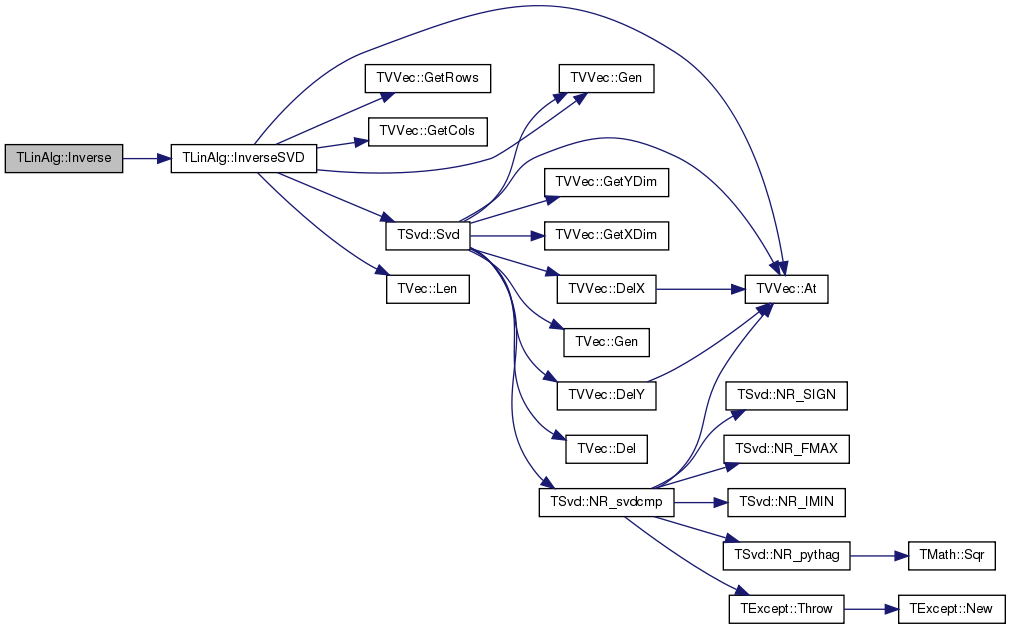
| void TLinAlg::InverseSVD | ( | const TFltVV & | A, |
| TFltVV & | B | ||
| ) | [static] |
Definition at line 555 of file linalg.cpp.
References TVVec< TVal >::At(), TVVec< TVal >::Gen(), TVVec< TVal >::GetCols(), TVVec< TVal >::GetRows(), TVec< TVal, TSizeTy >::Len(), and TSvd::Svd().
Referenced by Inverse().
{
// create temp matrices
TFltVV U, V;
TFltV E;
TSvd SVD;
U.Gen(M.GetRows(), M.GetRows());
V.Gen(M.GetCols(), M.GetCols());
// do the SVD decompostion
SVD.Svd(M, U, E, V);
// calculate reciprocal values for diagonal matrix = inverse diagonal
for (int i = 0; i < E.Len(); i++) {
E[i] = 1 / E[i];
}
// calculate pseudoinverse: M^(-1) = V * E^(-1) * U'
for (int i = 0; i < U.GetCols(); i++) {
for (int j = 0; j < V.GetRows(); j++) {
double sum = 0;
for (int k = 0; k < U.GetCols(); k++) {
sum += E[k] * V.At(i, k) * U.At(j, k);
}
B.At(i, j) = sum;
}
}
}


| void TLinAlg::LinComb | ( | const double & | p, |
| const TFltV & | x, | ||
| const double & | q, | ||
| const TFltV & | y, | ||
| TFltV & | z | ||
| ) | [static] |
Definition at line 218 of file linalg.cpp.
References Assert, and TVec< TVal, TSizeTy >::Len().
Referenced by AddVec(), and ConvexComb().
{
Assert(x.Len() == y.Len() && y.Len() == z.Len());
const int Len = x.Len();
for (int i = 0; i < Len; i++) {
z[i] = p * x[i] + q * y[i]; }
}


| void TLinAlg::Multiply | ( | const TFltVV & | A, |
| const TFltV & | x, | ||
| TFltV & | y | ||
| ) | [static] |
Definition at line 428 of file linalg.cpp.
References Assert, TVVec< TVal >::GetCols(), TVVec< TVal >::GetRows(), and TVec< TVal, TSizeTy >::Len().
Referenced by TSparseSVD::Lanczos(), and TSparseSVD::Lanczos2().
{
Assert(A.GetCols() == x.Len() && A.GetRows() == y.Len());
int n = A.GetRows(), m = A.GetCols();
for (int i = 0; i < n; i++) {
y[i] = 0.0;
for (int j = 0; j < m; j++)
y[i] += A(i,j) * x[j];
}
}


| void TLinAlg::Multiply | ( | const TFltVV & | A, |
| const TFltV & | x, | ||
| TFltVV & | C, | ||
| int | ColId | ||
| ) | [static] |
Definition at line 438 of file linalg.cpp.
References Assert, TVVec< TVal >::GetCols(), TVVec< TVal >::GetRows(), and TVec< TVal, TSizeTy >::Len().
{
Assert(A.GetCols() == x.Len() && A.GetRows() == C.GetRows());
int n = A.GetRows(), m = A.GetCols();
for (int i = 0; i < n; i++) {
C(i,ColId) = 0.0;
for (int j = 0; j < m; j++)
C(i,ColId) += A(i,j) * x[j];
}
}
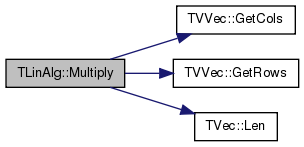
| void TLinAlg::Multiply | ( | const TFltVV & | A, |
| const TFltVV & | B, | ||
| int | ColId, | ||
| TFltV & | y | ||
| ) | [static] |
Definition at line 448 of file linalg.cpp.
References Assert, TVVec< TVal >::GetCols(), TVVec< TVal >::GetRows(), and TVec< TVal, TSizeTy >::Len().
{
Assert(A.GetCols() == B.GetRows() && A.GetRows() == y.Len());
int n = A.GetRows(), m = A.GetCols();
for (int i = 0; i < n; i++) {
y[i] = 0.0;
for (int j = 0; j < m; j++)
y[i] += A(i,j) * B(j,ColId);
}
}
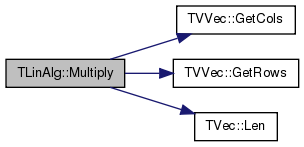
| void TLinAlg::Multiply | ( | const TFltVV & | A, |
| const TFltVV & | B, | ||
| int | ColIdB, | ||
| TFltVV & | C, | ||
| int | ColIdC | ||
| ) | [static] |
Definition at line 458 of file linalg.cpp.
References Assert, TVVec< TVal >::GetCols(), and TVVec< TVal >::GetRows().
{
Assert(A.GetCols() == B.GetRows() && A.GetRows() == C.GetRows());
int n = A.GetRows(), m = A.GetCols();
for (int i = 0; i < n; i++) {
C(i,ColIdC) = 0.0;
for (int j = 0; j < m; j++)
C(i,ColIdC) += A(i,j) * B(j,ColIdB);
}
}

| void TLinAlg::Multiply | ( | const TFltVV & | A, |
| const TFltVV & | B, | ||
| TFltVV & | C | ||
| ) | [static] |
Definition at line 478 of file linalg.cpp.
References Assert, TVVec< TVal >::GetCols(), and TVVec< TVal >::GetRows().
{
Assert(A.GetRows() == C.GetRows() && B.GetCols() == C.GetCols() && A.GetCols() == B.GetRows());
int n = C.GetRows(), m = C.GetCols(), l = A.GetCols();
for (int i = 0; i < n; i++) {
for (int j = 0; j < m; j++) {
double sum = 0.0;
for (int k = 0; k < l; k++)
sum += A(i,k)*B(k,j);
C(i,j) = sum;
}
}
}

| void TLinAlg::MultiplyScalar | ( | const double & | k, |
| const TFltV & | x, | ||
| TFltV & | y | ||
| ) | [static] |
Definition at line 414 of file linalg.cpp.
References Assert, and TVec< TVal, TSizeTy >::Len().
Referenced by Normalize(), NormalizeL1(), NormalizeLinf(), and TSparseSVD::SimpleLanczos().


| void TLinAlg::MultiplyScalar | ( | const double & | k, |
| const TIntFltKdV & | x, | ||
| TIntFltKdV & | y | ||
| ) | [static] |
Definition at line 421 of file linalg.cpp.
References Assert, and TVec< TVal, TSizeTy >::Len().
{
Assert(x.Len() == y.Len());
int Len = x.Len();
for (int i = 0; i < Len; i++)
y[i].Dat = k * x[i].Dat;
}

| void TLinAlg::MultiplyT | ( | const TFltVV & | A, |
| const TFltV & | x, | ||
| TFltV & | y | ||
| ) | [static] |
Definition at line 468 of file linalg.cpp.
References Assert, TVVec< TVal >::GetCols(), TVVec< TVal >::GetRows(), and TVec< TVal, TSizeTy >::Len().
{
Assert(A.GetRows() == x.Len() && A.GetCols() == y.Len());
int n = A.GetCols(), m = A.GetRows();
for (int i = 0; i < n; i++) {
y[i] = 0.0;
for (int j = 0; j < m; j++)
y[i] += A(j,i) * x[j];
}
}
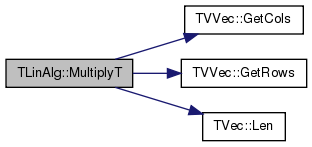
| double TLinAlg::Norm | ( | const TFltV & | x | ) | [static] |
Definition at line 324 of file linalg.cpp.
References Norm2().
Referenced by GS(), TSparseSVD::Lanczos(), TSparseSVD::Lanczos2(), TAGMFit::MLEGradAscentGivenCAG(), TLogRegFit::MLEGradient(), Normalize(), TSparseSVD::OrtoIterSVD(), and TSparseSVD::SimpleLanczos().
{
return sqrt(Norm2(x));
}

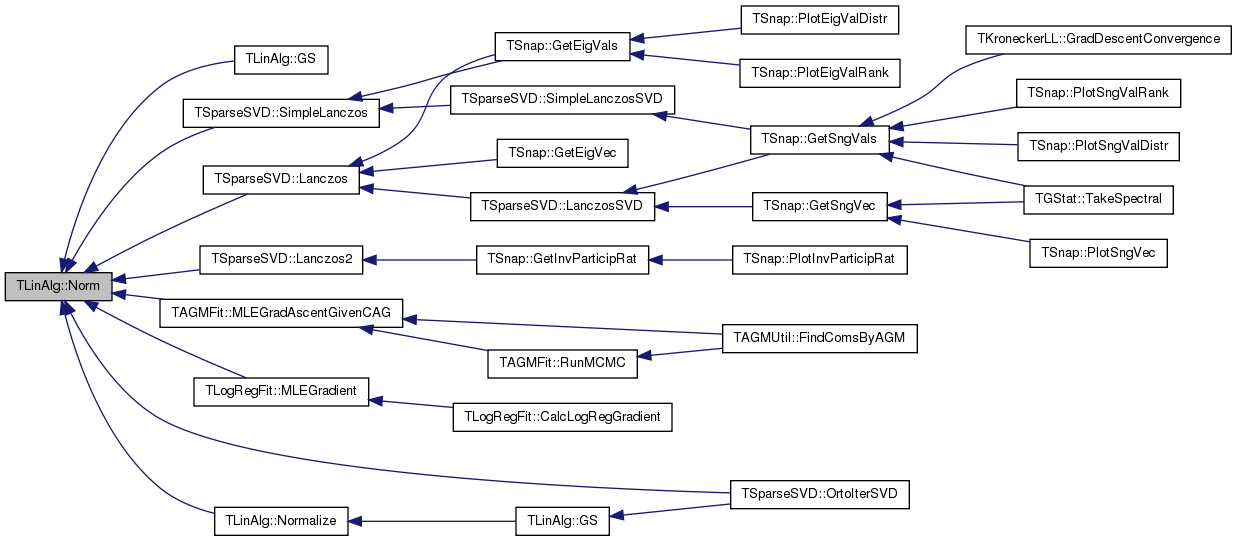
| double TLinAlg::Norm | ( | const TIntFltKdV & | x | ) | [static] |
Definition at line 341 of file linalg.cpp.
References Norm2().
{
return sqrt(Norm2(x));
}

| double TLinAlg::Norm | ( | const TFltVV & | X, |
| int | ColId | ||
| ) | [static] |
Definition at line 353 of file linalg.cpp.
References Norm2().
{
return sqrt(Norm2(X, ColId));
}

| double TLinAlg::Norm2 | ( | const TFltV & | x | ) | [static] |
Definition at line 320 of file linalg.cpp.
References DotProduct().
Referenced by AssertOrtogonality(), TCesna::MLEGradAscent(), TCesna::MLEGradAscentParallel(), and Norm().
{
return DotProduct(x, x);
}

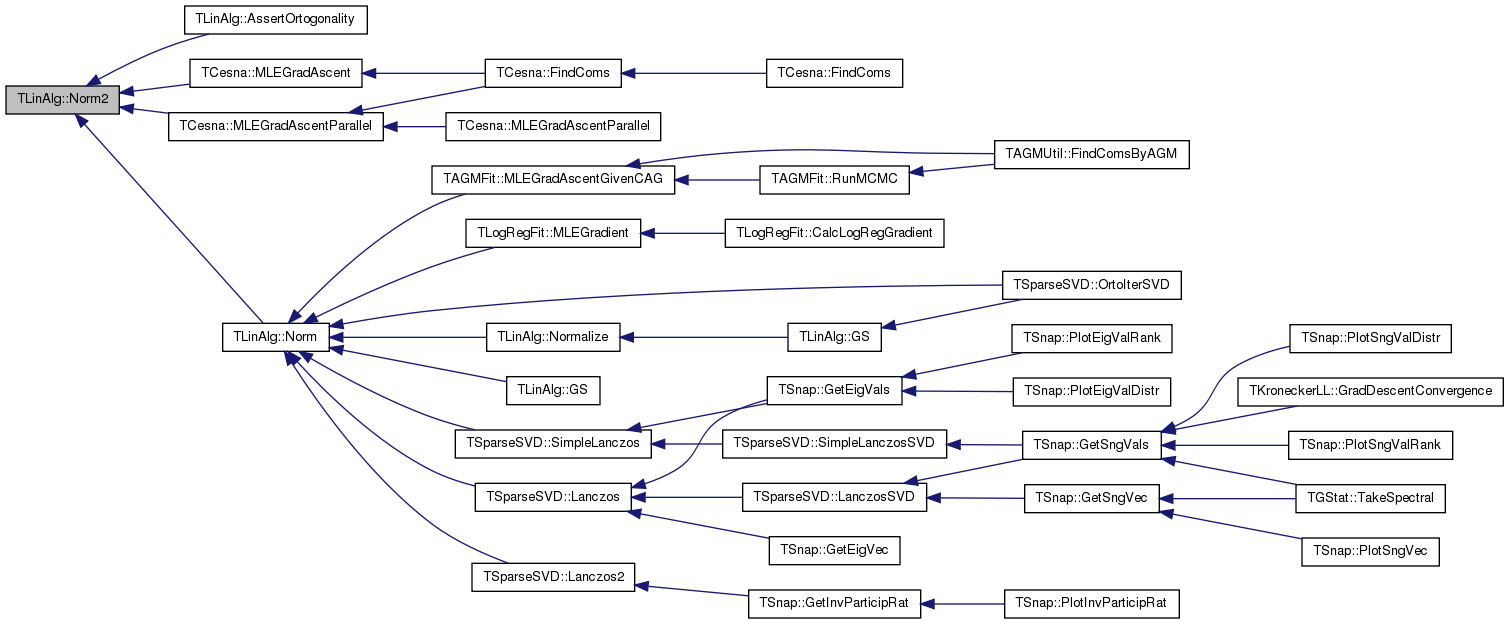
| double TLinAlg::Norm2 | ( | const TIntFltKdV & | x | ) | [static] |
Definition at line 333 of file linalg.cpp.
References TVec< TVal, TSizeTy >::Len(), and TMath::Sqr().
{
double Result = 0;
for (int i = 0; i < x.Len(); i++) {
Result += TMath::Sqr(x[i].Dat);
}
return Result;
}

| double TLinAlg::Norm2 | ( | const TFltVV & | X, |
| int | ColId | ||
| ) | [static] |
Definition at line 349 of file linalg.cpp.
References DotProduct().
{
return DotProduct(X, ColId, X, ColId);
}

| void TLinAlg::Normalize | ( | TFltV & | x | ) | [static] |
Definition at line 328 of file linalg.cpp.
References MultiplyScalar(), and Norm().
Referenced by GS().
{
const double xNorm = Norm(x);
if (xNorm > 0.0) { MultiplyScalar(1/xNorm, x, x); }
}


| void TLinAlg::Normalize | ( | TIntFltKdV & | x | ) | [static] |
Definition at line 345 of file linalg.cpp.
References MultiplyScalar(), and Norm().
{
MultiplyScalar(1/Norm(x), x, x);
}

| void TLinAlg::NormalizeL1 | ( | TFltV & | x | ) | [static] |
Definition at line 380 of file linalg.cpp.
References MultiplyScalar(), and NormL1().
{
const double xNorm = NormL1(x);
if (xNorm > 0.0) { MultiplyScalar(1/xNorm, x, x); }
}

| void TLinAlg::NormalizeL1 | ( | TIntFltKdV & | x | ) | [static] |
Definition at line 385 of file linalg.cpp.
References MultiplyScalar(), and NormL1().
{
const double xNorm = NormL1(x);
if (xNorm > 0.0) { MultiplyScalar(1/xNorm, x, x); }
}

| void TLinAlg::NormalizeLinf | ( | TFltV & | x | ) | [static] |
Definition at line 404 of file linalg.cpp.
References MultiplyScalar(), and NormLinf().
{
const double xNormLinf = NormLinf(x);
if (xNormLinf > 0.0) { MultiplyScalar(1.0/xNormLinf, x, x); }
}

| void TLinAlg::NormalizeLinf | ( | TIntFltKdV & | x | ) | [static] |
Definition at line 409 of file linalg.cpp.
References MultiplyScalar(), and NormLinf().
{
const double xNormLInf = NormLinf(x);
if (xNormLInf> 0.0) { MultiplyScalar(1.0/xNormLInf, x, x); }
}

| double TLinAlg::NormL1 | ( | const TFltV & | x | ) | [static] |
Definition at line 357 of file linalg.cpp.
References TFlt::Abs(), and TVec< TVal, TSizeTy >::Len().
Referenced by NormalizeL1().
{
double norm = 0.0; const int Len = x.Len();
for (int i = 0; i < Len; i++)
norm += TFlt::Abs(x[i]);
return norm;
}


| double TLinAlg::NormL1 | ( | double | k, |
| const TFltV & | x, | ||
| const TFltV & | y | ||
| ) | [static] |
Definition at line 364 of file linalg.cpp.
References TFlt::Abs(), Assert, and TVec< TVal, TSizeTy >::Len().
{
Assert(x.Len() == y.Len());
double norm = 0.0; const int len = x.Len();
for (int i = 0; i < len; i++) {
norm += TFlt::Abs(k * x[i] + y[i]);
}
return norm;
}

| double TLinAlg::NormL1 | ( | const TIntFltKdV & | x | ) | [static] |
Definition at line 373 of file linalg.cpp.
References TFlt::Abs(), and TVec< TVal, TSizeTy >::Len().
{
double norm = 0.0; const int Len = x.Len();
for (int i = 0; i < Len; i++)
norm += TFlt::Abs(x[i].Dat);
return norm;
}

| double TLinAlg::NormLinf | ( | const TFltV & | x | ) | [static] |
Definition at line 390 of file linalg.cpp.
References TFlt::Abs(), TFlt::GetMx(), and TVec< TVal, TSizeTy >::Len().
Referenced by NormalizeLinf().
{
double norm = 0.0; const int Len = x.Len();
for (int i = 0; i < Len; i++)
norm = TFlt::GetMx(TFlt::Abs(x[i]), norm);
return norm;
}
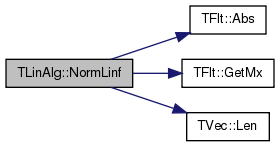

| double TLinAlg::NormLinf | ( | const TIntFltKdV & | x | ) | [static] |
Definition at line 397 of file linalg.cpp.
References TFlt::Abs(), TFlt::GetMx(), and TVec< TVal, TSizeTy >::Len().
{
double norm = 0.0; const int Len = x.Len();
for (int i = 0; i < Len; i++)
norm = TFlt::GetMx(TFlt::Abs(x[i].Dat), norm);
return norm;
}
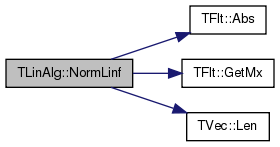
| void TLinAlg::Rotate | ( | const double & | OldX, |
| const double & | OldY, | ||
| const double & | Angle, | ||
| double & | NewX, | ||
| double & | NewY | ||
| ) | [static] |
Definition at line 611 of file linalg.cpp.
{
NewX = OldX*cos(Angle) - OldY*sin(Angle);
NewY = OldX*sin(Angle) + OldY*cos(Angle);
}
| double TLinAlg::SumVec | ( | const TFltV & | x | ) | [static] |
Definition at line 279 of file linalg.cpp.
References TVec< TVal, TSizeTy >::Len().
Referenced by TAGMFit::Likelihood().
{
const int len = x.Len();
double Res = 0.0;
for (int i = 0; i < len; i++) {
Res += x[i];
}
return Res;
}


| double TLinAlg::SumVec | ( | double | k, |
| const TFltV & | x, | ||
| const TFltV & | y | ||
| ) | [static] |
Definition at line 288 of file linalg.cpp.
References Assert, and TVec< TVal, TSizeTy >::Len().
{
Assert(x.Len() == y.Len());
const int len = x.Len();
double Res = 0.0;
for (int i = 0; i < len; i++) {
Res += k * x[i] + y[i];
}
return Res;
}

| void TLinAlg::Transpose | ( | const TFltVV & | A, |
| TFltVV & | B | ||
| ) | [static] |
Definition at line 539 of file linalg.cpp.
References Assert, TVVec< TVal >::At(), TVVec< TVal >::GetCols(), and TVVec< TVal >::GetRows().
{
Assert(B.GetRows() == A.GetCols() && B.GetCols() == A.GetRows());
for (int i = 0; i < A.GetCols(); i++) {
for (int j = 0; j < A.GetRows(); j++) {
B.At(i, j) = A.At(j, i);
}
}
}
